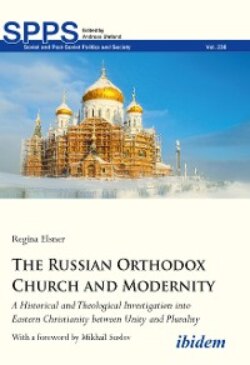The Russian Orthodox Church and Modernity

Реклама. ООО «ЛитРес», ИНН: 7719571260.
Оглавление
Regina Elsner. The Russian Orthodox Church and Modernity
Foreword
Acknowledgment
1 Introduction
Modernity
Methodological preliminary remarks
2 Russian Orthodoxy and Modernization: Seven Historical Snapshots
2.1 15th/16th century: The crisis of tradition
The Relationship between state and church in Byzantine and Russian tradition
The question of the true tradition
Dealing with dissent
Conclusions
2.2 The crisis of belonging: The liturgical reforms of the 17th century
The tension between diversity and uniformity
The tension between old and new
The interaction of church and state
The link between form and content
Conclusions
2.3 The crisis of the self-evident: Peter I's reforms and the synodal period
Theology and theological thought at the beginning of the 18th century
The relationship between church and state
The West as a model and a threat
Society between fragmentation and unity
Conclusions
2.4 Religious-philosophical awakening in the 19th century
Church reactions to the new religious-ideological diversity
The contribution of Slavophiles to Orthodox theology
The dawn of Russian religious philosophy, "Russian school" and "new religious consciousness"
Conclusions
2.5 The Local Council of the Russian Orthodox Church 1917-1918
The relationship between state and church
Ecclesiology between democratising and episcopal interpretation
Conclusions
2.6 The Orthodox Church in the Soviet Union
Desire for renewal and the Renovationist movement47
Adaptation and resistance
Conclusions
2.7 The challenge of freedom: The end of the Soviet Union and the dawn of the 21st century
The challenge of religious freedom
The challenge of freedom of expression: the struggle against modernism and "neo-renovationism" in the Church
Conclusions
2.8 Summary: Central argumentation lines
Renewal as a danger
"A Christian cannot not be a patriot of his fatherland, especially in Russia..." (Kozlov 2011): Interdependence with the (autocratic) state
In the world, but not of the world: The church as god-human organism in the world
The West as a threat
Conclusions
3 Dogmatic Orientations and the Tension between Unity and Diversity
3.1 The incomprehensibility of the trinitarian unity of diversity
The limits of speaking about God
One God—three Persons: Focal points of the depiction
1) Biblical foundations
2) Demarcation against the accusation of polytheism and against unacceptable hierarchies within the Trinity
3) Clarification of the trinitarian terminology and the energies of God
4) Limits of the comprehensibility of the trinitarian mystery
Possibilities of transferability: Trinitarian relationships to the world
Crossing the boundaries of dogma: new theological approaches and the question of the practical effect of the doctrine of the Trinity
Conclusions
3.2 Human being between unity and multiplicity
The paradigm of “humanity’s likeness to God”
The human being between personhood and individuality
God-humanity and Deification
Alternative ways of thinking: Anthropological turn and God-humanity
Conclusions
3.3 Church communion as unity in diversity
The "one" and "catholic" (sobornaya) Church
1) The unity of the church
2)The catholicity (sobornost') of the Church
Sobornost' as a central concept of (theological) social criticism?
Ecclesiological awakenings in the 20th century
Conclusions
3.4 Summary: The tension between unity and diversity as a paradigm of Russian Orthodox theology
4 Theological Answers to Secular Challenges?
4.1 The unity of the Church and diversity in the Church. Primacy of unity
Formal centralisation
'Reforms are possible, but not necessary'. Retreat to formalized unity
4.2 The unity of the people and diversity of opinion. The ROC as the voice of the people
Democracy as harmonisation of interests
One civilisation, one people, one morality
4.3 The unity of the world and cultural diversity. Traditional values in the age of globalisation
Peace in times of globalisation
5 Conclusion
Bibliography. Sources. Official Documents
Arkhiereiskii Sobor 1994:
Arkhiereiskii Sobor 1997:
Arkhiereiskii Sobor 2000:
Arkhiereiskii Sobor 2008:
Collections of Sources
Official Statements. Alexei (Ridiger) [= Patriarch Alexei II.]:
Hilarion (Alfeyev) [= Mitropolit Volokolamskogo Ilarion]:
Kirill (Gundyaev) [= Patriarch Moskovsgogo i vseia Rusi]:
Further Sources
Articles
Literature
Отрывок из книги
ibidem Press, Stuttgart
Acknowledgment
.....
3.3 Church communion as unity in diversity
3.4 Summary: The tension between unity and diversity as a paradigm of Russian Orthodox theology
.....